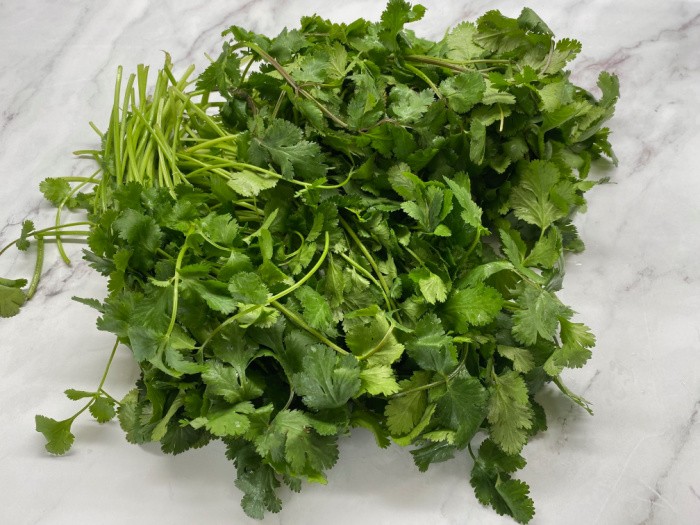
I want to show you today how to dehydrate Cilantro from the garden as you learn to preserve the fun items you may have grown yourself. I dehydrated some Cilantro about three years ago and I was hooked on it. Thankfully Cilantro grows like a weed! All you need is good soil and some awesome seeds and you are ready to plant. It sprouts here in my dry area of Utah in about two weeks, so don’t give up if you don’t see those little leaves start sprouting right away.
The only downside to growing your own Cilantro is once you clip it, your crop is done. In other words, you have to replant some more seeds. But, here’s the deal, you can grow so much that one crop can give you bunches of Cilantro to eat and preserve since a bunch of Cilantro tends to go a long way like many dried herbs. Drying fresh herbs can prove to be a fun activity for a family that grows and preserves their own food for storage and even long-term use.
Having some dried Cilantro can make a real difference when it comes to adding a unique flavor to many of your recipes as you add the dried Cilantro leaves or powder as directed. Another great feature of drying Cilantro is that it takes so little of your time.
I wrote this post back in 2016 and I feel an urgency to share a way for people to preserve their food from a garden, the store, or a Farmer’s Market. It’s critical to have food stored before you need it.
Options for Dehydrating
You don’t have to buy a fancy dehydrator unless you plan on dehydrating everything you can get your hands on like me. You can dehydrate / air-dry Cilantro in your car on the dashboard in direct sunlight on top of a clean window screen or cookie sheet. I wouldn’t dehydrate herbs or spice choices in my car since many put out a strong odor that may take weeks or months to go away. That’s my personal choice and I prefer a dehydrator. Air drying can be a cheap way to dry food, but be careful with spills since the dried food can crumble and go every which way.
Just giving you the heads-up here. Once when my daughters were really little we chopped onions to dehydrate in the house, yes you only do this once. We cut out sugar cookies for the Christmas tree to hang on the tree and didn’t realize those cute cookies would taste like onions. I called it a learning moment. The cookies looked fabulous but tasted like onions. Yikes! We dehydrated onions the next year outside on the patio.
Using Your Oven to Dehydrate
You can also dry foods in your oven. You need an oven with a low-temperature bake setting available, around 170 degrees is best. If yours won’t go that low, use the lowest setting, put your food on a baking tray or cookie sheet, and keep the oven door ajar using a wad of foil. Be sure to check on the food often to make sure the dehydrated foods don’t get too dry.
I love using my dehydrator because I don’t want a lot of food in the freezer to go bad in case we lose power. Once you start dehydrating you will use your dehydrator all the time. Please note, I don’t dehydrate my food for long-term storage. I leave that for the commercial processing companies. If you think about it if you have a bundle of bananas that are going to go bad, dehydrate them for healthy snacks. You can do the same with any fruit or vegetable. If you dehydrate vegetables they would have to be cooked with water to soften them prior to eating or you may chip your front tooth. LOL!
Can’t you just smell the Cilantro? When I cut it outside my hands and arms smell like it for days! Oh, how I love that smell. This is how it looks after it is dehydrated below.
How To Dehydrate Cilantro
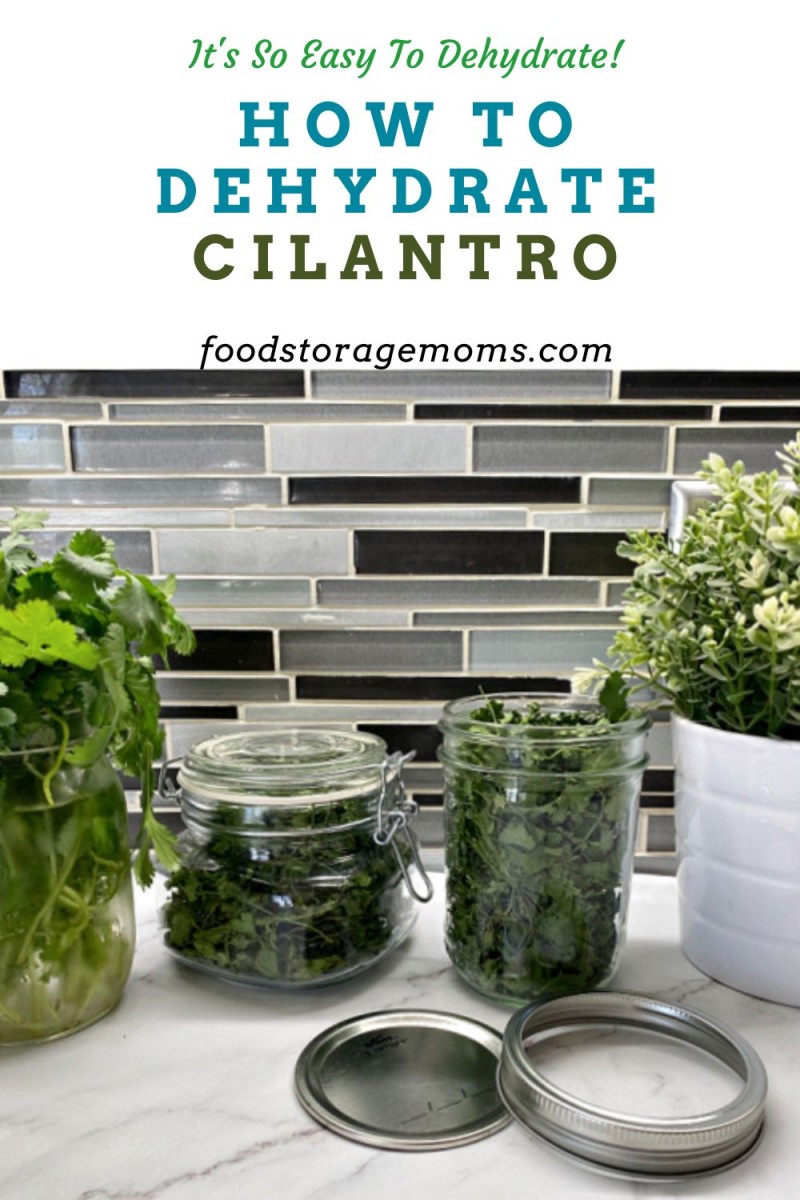
Step One: Turn on Dehydrator
I set my Excalibur Dehydrator at (115°F) = (46°C) degrees before I got started to prep the Cilantro.
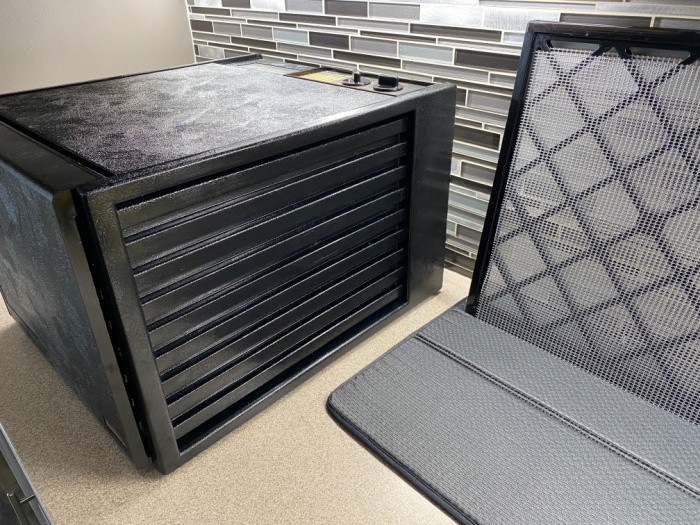
Step Two: Examine the Cilantro
Check the Cilantro and remove any damaged leaves or sprigs.

Step Three: Wash the Cilantro
Wash and drain the Cilantro. I use a salad spinner to make sure I get all the moisture off the leaves.
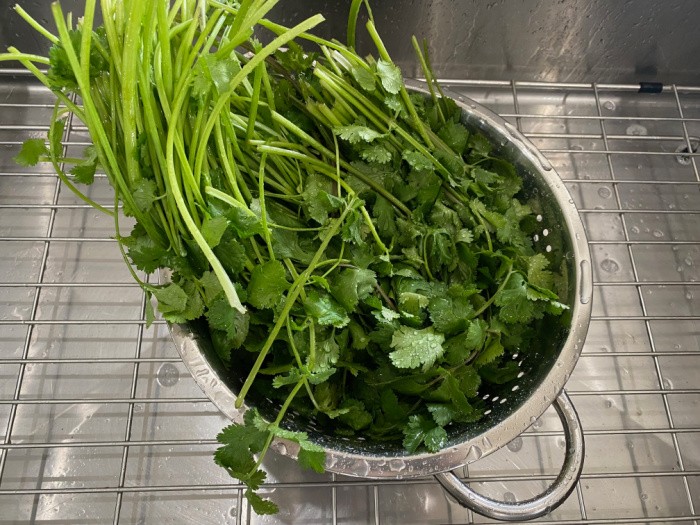
Step Four: Cut off Stems
Cut the stems off of the Cilantro and discard them, I prefer not to dehydrate the stems.
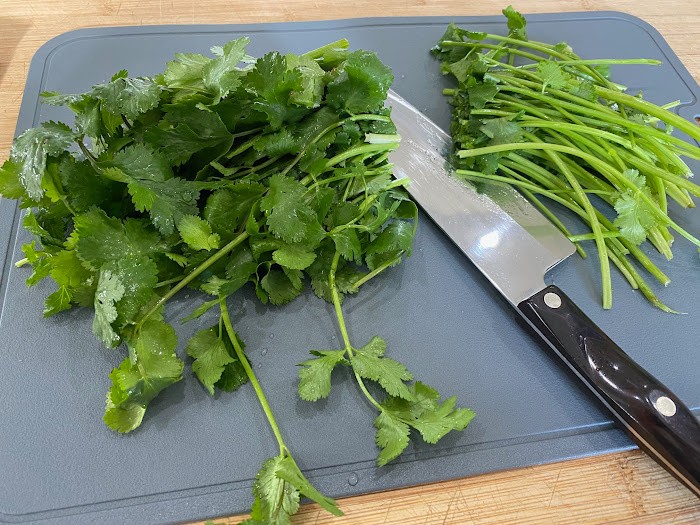
Step Five: Place the Cilantro on Dehydrator Trays or Racks
Place the Cilantro sprigs evenly on your dehydrator trays or racks. Try to make a single layer so the air gets around them more easily. This prompts the leaves to dry more quickly.
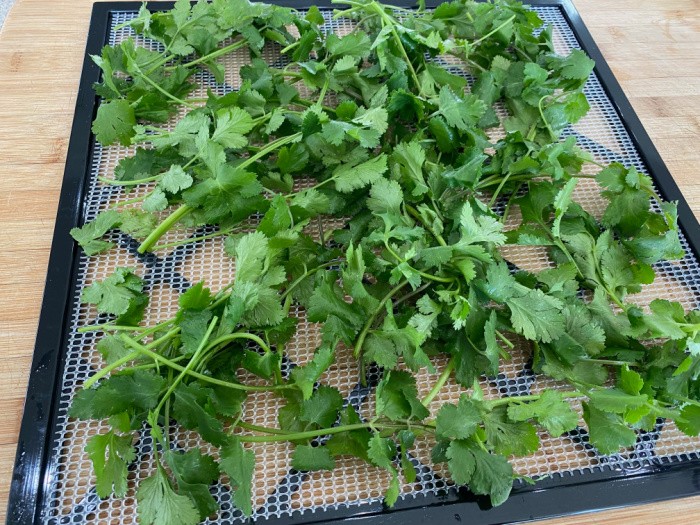
Step Six: Dehydrate until Completely Dry
It took two hours today to dehydrate my Cilantro. Please remember, it will always depend on the humidity in the area where you are dehydrating and the temperature setting used. Some dehydrator brands may suggest a different time and temperature setting than mine.
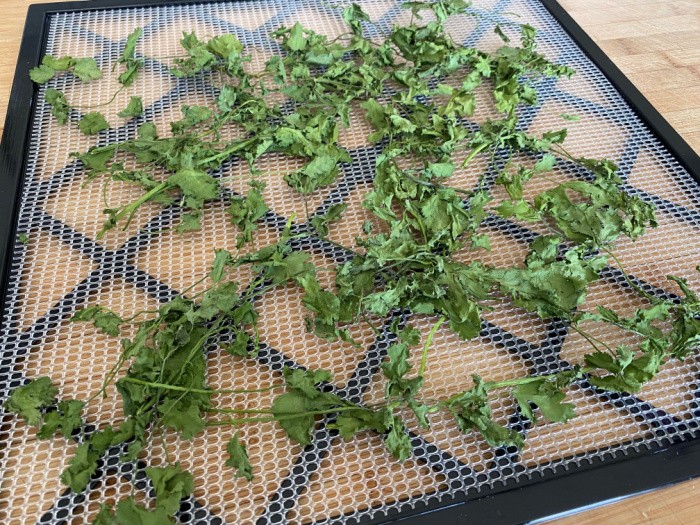
Step Seven: Condition Cilantro
If you live where it’s HUMID: “To condition the fruit, take the dried fruit that has cooled and pack it loosely in plastic or a glass mason jar. Seal the containers and let them stand for 7 to 10 days. The excess moisture in some pieces will be absorbed by the drier pieces. Shake the jars daily to separate the pieces and check the moisture condensation.” https://nchfp.uga.edu/how/dry/pack_store.html
I used to live in the DRY DESERT: I set my fruit and vegetables on my countertop for 5-7 days. Ten days are even better to make sure everything is dry before using your FoodSaver unit.
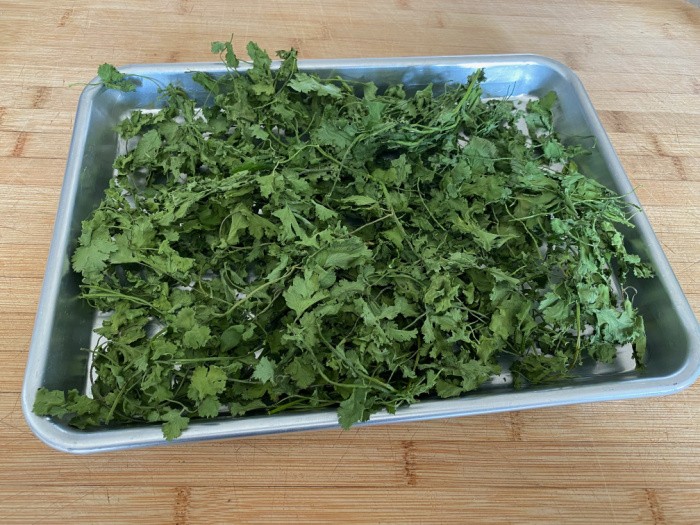
Step Eight: Place the Dried Cilantro in Glass Mason Jars
I placed the Cilantro in pint-size jars and used my FoodSaver to remove any air to prolong its storage life. Having airtight container jars makes a real difference in shelf life.
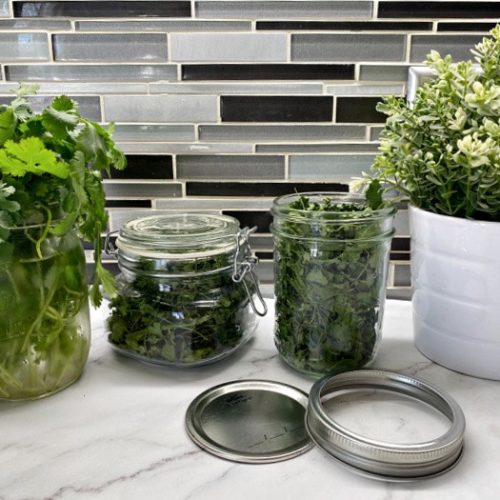
How To Dehydrate Cilantro
Ingredients
- 3-4 sprigs/sections fresh Cilantro
Instructions
- I set my Excalibur Dehydrator at (115°F) = (46°C) degrees before I got started to prep the Cilantro.
- Check the Cilantro and remove any damaged leaves or sprigs.
- Wash and drain the Cilantro.
- Cut the stems off of the Cilantro and discard them, I prefer not to dehydrate them.
- Place the Cilantro sprigs evenly on your dehydrator racks.
- These took two hours today to dehydrate. Please remember it will always depend on the humidity in the area where you are dehydrating.
Condition The Cilantro
- If you live where it’s HUMID: “To condition the fruit, take the dried fruit that has cooled and pack it loosely in plastic or glass jars. Seal the containers and let them stand for 7 to 10 days. The excess moisture in some pieces will be absorbed by the drier pieces. Shake the jars daily to separate the pieces and check the moisture condensation.” https://nchfp.uga.edu/how/dry/pack_store.html I used to live in the DRY DESERT: As mentioned, I set my fruit and vegetables on my countertop for 5-7 days. Ten days is even better to make sure everything is dry before using your FoodSaver unit.
- I placed the Cilantro in pint-size jars and used my FoodSaver to remove any air to prolong its storage life.
Preserve Cilantro by Freezing:
Another option for preservation is freezing Cilantro in bags. I freeze spinach and basil all the time. I wouldn’t keep it in the freezer over two months or so, but man is it good in freshly made buttermilk dressing. In Utah, we call it Ranch dressing. If you use the blender, just add a small handful of Cilantro into the mixture and it has a little kick to it. Most meal dishes you make like soups and stews, or even a garnish, are benefited by you adding a flavorful herb such as dill, oregano, or thyme, to name a few.
Here are the other Dehydrating Posts I have done:
- Dehydrating Apples
- Dehydrating Bananas
- Dehydrating Blackberries and Powder
- Dehydrating Blueberries and Powder
- Dehydrating Cilantro
- Dehydrating Cucumbers and Powder
- Dehydrating Ginger and Powder
- Dehydrating Grapes
- Dehydrating Green Onions and Powder
- Dehydrating Kale and Kale Powder
- Dehydrating Kiwi
- Dehydrating Lemons and Powder
- Dehydrating Marshmallows
- Dehydrating Peppermint Marshmallows and Powder
- Dehydrating Mushrooms and Mushroom Powder
- Dehydrating Onions and Powder
- How To Dehydrate Parsley and Powder
- Dehydrating Pears
- Dehydrating Pineapple
- Dehydrating Raspberries and Powder
- Dehydrating Spinach and Powder
- Dehydrating Strawberries
- Dehydrating Tomatoes and Powder
- Dehydrating Watermelon
Final Word
I hope you enjoyed my post today on how to dehydrate Cilantro. Here’s the deal, if you grow Cilantro you can dehydrate it and use it during the winter when you may not be able to garden. I put Cilantro stored in my pantry in salads, salsa on tacos, and with cooked rice. Just add it as you cook your meat, rice, or make salad dressing. Let me know how you use your Cilantro. It’s so good! May God Bless this world, Linda
The post How To Dehydrate Cilantro appeared first on Food Storage Moms.
